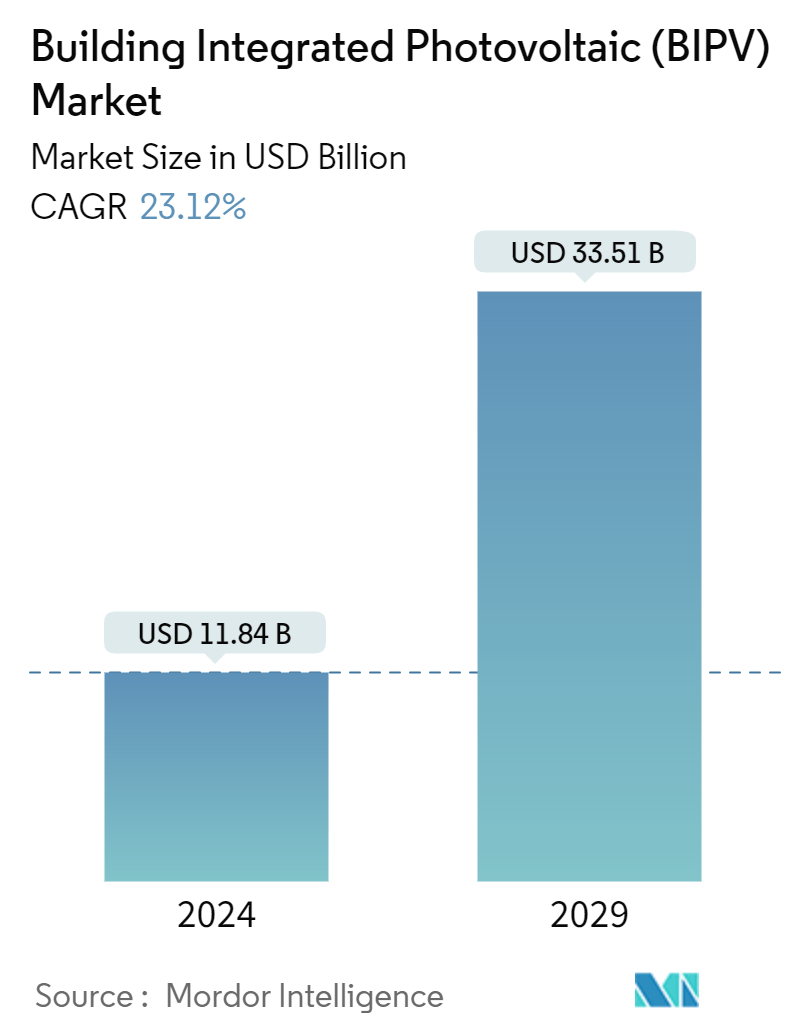Market Size of Building Integrated Photovoltaic (BIPV) Industry

| Study Period | 2019 - 2029 |
| Market Size (2024) | USD 11.84 Billion |
| Market Size (2029) | USD 33.51 Billion |
| CAGR (2024 - 2029) | 23.12 % |
| Fastest Growing Market | Asia Pacific |
| Largest Market | Europe |
Major Players-Market.webp)
*Disclaimer: Major Players sorted in no particular order |
Building Integrated Photovoltaic (BIPV) Market Analysis
The Building Integrated Photovoltaic Market size is estimated at USD 11.84 billion in 2024, and is expected to reach USD 33.51 billion by 2029, growing at a CAGR of 23.12% during the forecast period (2024-2029).
- Factors such as high-rise multi-story buildings and supportive government initiatives are expected to drive the market during the forecast period.
- On the other hand, the high installation cost compared to rooftop PV systems will likely negatively impact the market’s growth.
- Nevertheless, the rapid urbanization and development of smart cities are enormous opportunities for BIPV systems. The governments of almost all countries are moving toward renewables-oriented energy policies to reach their carbon neutrality goals.
- Asia-Pacific is expected to dominate the building-integrated photovoltaics market due to declining solar technology costs.
Building Integrated Photovoltaic (BIPV) Industry Segmentation
Building-integrated photovoltaics (BIPVs) are solar power-producing products or systems that are effortlessly integrated into the building envelope and parts of building apparatuses such as façades, roofs, or windows. A BIPV system serves a dual purpose and is an integral component of the building skin that concurrently converts solar energy into electrical energy.
The building-integrated photovoltaics market is segmented by type, end-user, and geography. By type, the market is segmented into thin-film PV and crystalline PV. By end-user, the market is segmented into residential and commercial and industrial. The report also covers the market size and forecasts across major regions. The market sizing and forecasts have been done for each segment based on revenue (USD).
| Type | |
| Thin-film PV | |
| Crystalline PV |
| End User | |
| Residential | |
| Commercial and Industrial |
| Geography | |||||||||||
| |||||||||||
| |||||||||||
| |||||||||||
| |||||||||||
|
Building Integrated Photovoltaic (BIPV) Market Size Summary
The building-integrated photovoltaics (BIPV) market is poised for significant growth, driven by the increasing adoption of renewable energy solutions in urban development and smart city initiatives. The market is expected to expand substantially over the forecast period, supported by government policies favoring renewable energy and the growing trend of high-rise multi-story buildings. Despite the challenge of higher installation costs compared to traditional rooftop photovoltaic systems, the demand for BIPV is bolstered by rapid urbanization and the global shift towards carbon neutrality. The Asia-Pacific region is anticipated to lead the market, benefiting from declining solar technology costs and the region's mature solar PV industry.
Crystalline silicon technology dominates the BIPV market, with its widespread use in facades, curtain walls, and roofs due to its maturity and efficiency. This technology not only generates electricity but also enhances building performance by providing shade and improving thermal comfort. Recent developments, such as new manufacturing facilities in India and innovative product offerings from companies like Invitaic, are expected to further propel the market. The BIPV market is semi-consolidated, with key players like Onyx Solar Energy SL and AGC Inc. contributing to its growth. As BIPVs continue to gain traction, they are set to play a crucial role in promoting sustainability in the construction industry, aligning with the increasing emphasis on green building certifications and energy efficiency.
Building Integrated Photovoltaic (BIPV) Market Size - Table of Contents
-
1. MARKET OVERVIEW
-
1.1 Introduction
-
1.2 Market Size and Demand Forecast, till 2029
-
1.3 Recent Trends and Developments
-
1.4 Government Policies and Regulations
-
1.5 Market Dynamics
-
1.5.1 Drivers
-
1.5.1.1 High-rise Multi-story Buildings
-
1.5.1.2 Supportive Government Initiatives
-
-
1.5.2 Restraints
-
1.5.2.1 High Installation Cost as Compared to Rooftop PV Systems
-
-
-
1.6 Supply Chain Analysis
-
1.7 Porter's Five Forces Analysis
-
1.7.1 Bargaining Power of Suppliers
-
1.7.2 Bargaining Power of Consumers
-
1.7.3 Threat of New Entrants
-
1.7.4 Threat of Substitutes Products and Services
-
1.7.5 Intensity of Competitive Rivalry
-
-
-
2. MARKET SEGMENTATION
-
2.1 Type
-
2.1.1 Thin-film PV
-
2.1.2 Crystalline PV
-
-
2.2 End User
-
2.2.1 Residential
-
2.2.2 Commercial and Industrial
-
-
2.3 Geography
-
2.3.1 North America
-
2.3.1.1 United States
-
2.3.1.2 Canada
-
2.3.1.3 Rest of North America
-
-
2.3.2 Europe
-
2.3.2.1 Germany
-
2.3.2.2 France
-
2.3.2.3 United Kingdom
-
2.3.2.4 Turkey
-
2.3.2.5 Spain
-
2.3.2.6 NORDIC
-
2.3.2.7 Russia
-
2.3.2.8 Rest of Europe
-
-
2.3.3 Asia-Pacific
-
2.3.3.1 China
-
2.3.3.2 India
-
2.3.3.3 Japan
-
2.3.3.4 South Korea
-
2.3.3.5 Malaysia
-
2.3.3.6 Thailand
-
2.3.3.7 Indonesia
-
2.3.3.8 Vietnam
-
2.3.3.9 Rest of Asia-Pacific
-
-
2.3.4 South America
-
2.3.4.1 Brazil
-
2.3.4.2 Argentina
-
2.3.4.3 Colombia
-
2.3.4.4 Rest of South America
-
-
2.3.5 Middle East and Africa
-
2.3.5.1 Saudi Arabia
-
2.3.5.2 United Arab Emirates
-
2.3.5.3 South Africa
-
2.3.5.4 Nigeria
-
2.3.5.5 Qatar
-
2.3.5.6 Egypt
-
2.3.5.7 Rest of Middle East and Africa
-
-
-
Building Integrated Photovoltaic (BIPV) Market Size FAQs
How big is the Building Integrated Photovoltaic Market?
The Building Integrated Photovoltaic Market size is expected to reach USD 11.84 billion in 2024 and grow at a CAGR of 23.12% to reach USD 33.51 billion by 2029.
What is the current Building Integrated Photovoltaic Market size?
In 2024, the Building Integrated Photovoltaic Market size is expected to reach USD 11.84 billion.

